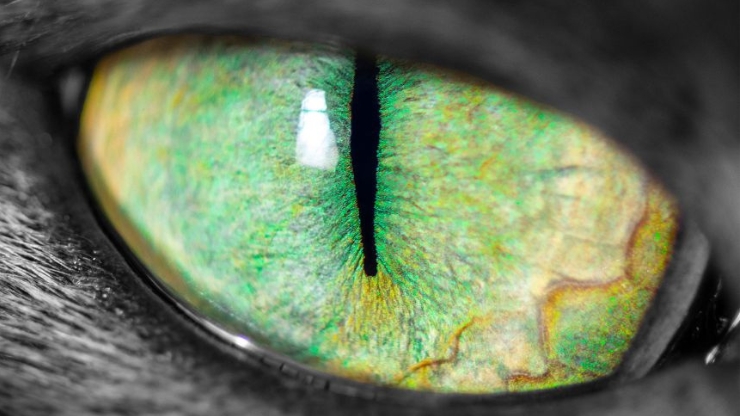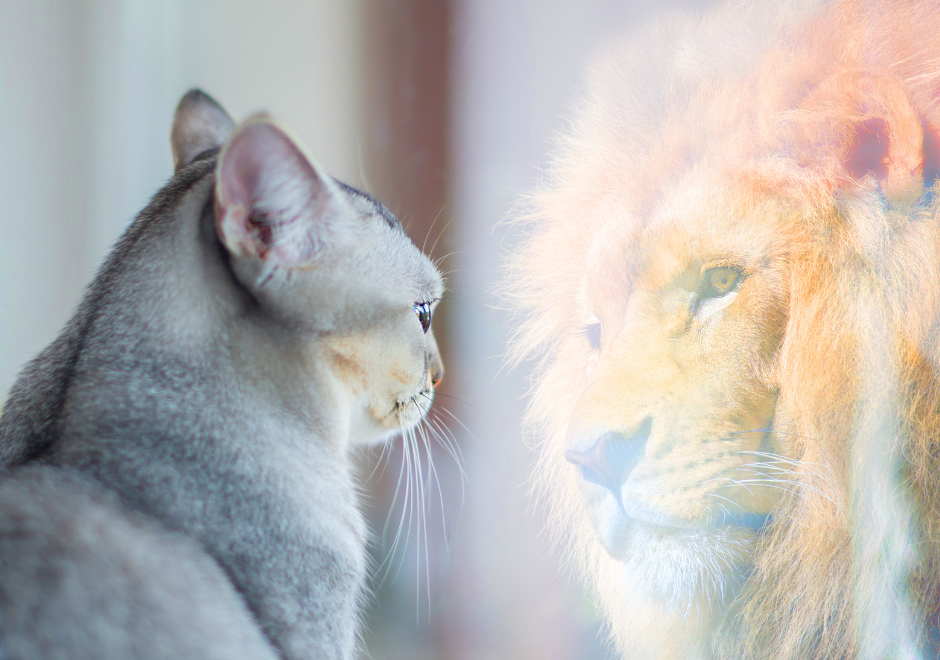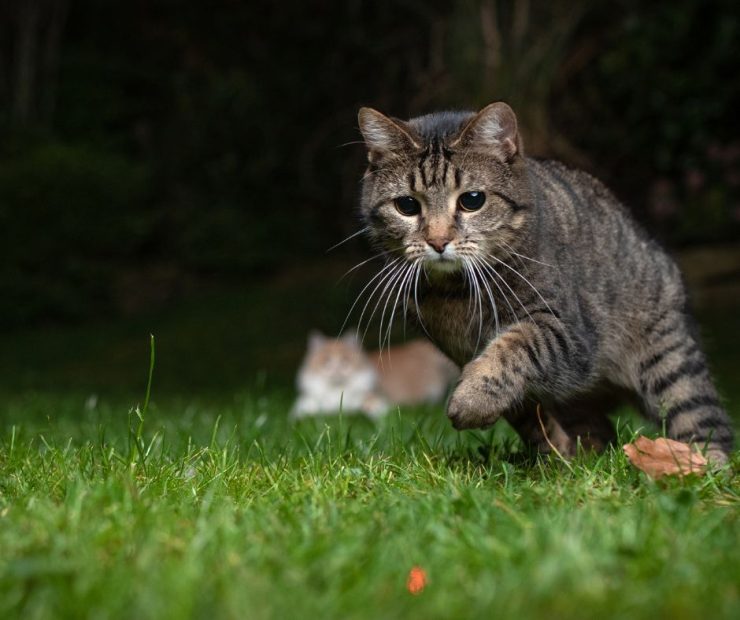Cats have tremendous eyesight, as any well-adapted carnivore should, but they see differently than humans. Although your cat will depend on its sense of smell in many situations, a cat’s vision is probably the most important for helping them to find and catch prey. Cats will hunt both in the daylight and at night. They need highly adjustable eyes that can function in bright sunlight, as well as gather lots of light in darkness. In this way, they are much like us.

However, the cat’s ability to adapt to changing light conditions is much greater than humans. You have probably heard that cats see better than humans at night, and it is true.
Any animal that has large eyes and pupils will be better able to use whatever light is available better than an animal with smaller eyes. Cats have both large eyes and very large pupils. You may not realize it, but your cat’s eyes are only slightly smaller than your own, even though his body and head are so much smaller than yours.
Cat Pupils
Cats, just like humans, can dilate or contract their pupils. They contract them to regulate the amount of light coming into their eyes on bright days and they dilate them to allow more light to enter in dark environments.
The pupils of a cat will contract to nothing more than a vertical slit on a bright sunny day. In darkness, however, their pupils will dilate to such a size that they seem to take up almost the entire eye, expanding up to 1/2 inch, or 1 cm. If this doesn’t sound all that big, take out a ruler and check, then think about the size of your cat’s eyes. It’s huge!

In addition to the large eyes and pupils, the cornea and lens are positioned close to the center of the eye, and the lens is set very close to the retina, to allow the retina to concentrate light.
Like humans, cats have two types of light-sensitive cells in their eyes, rods and cones, the same as all mammals. The cones are the color-detecting cells, whereas rods do not detect color, but can detect low levels of light.
Are Cats Color Blind?
Many people think that cats and dogs only see in black and white. However, it was shown many years ago through careful experimentation that cats do see colors. They do not see as many colors as humans, though, and the colors they do see are not as sharp and saturated. Cats are not colorblind, but they are color-limited, compared to humans.
The evidence is mixed concerning what colors cats can distinguish. Some evidence seems to show that cats see mostly reds and blues, but have a harder time with greens, yellows, and shades of white.
Other evidence points to cats seeing mostly green and blue, and maybe red. The prevailing scientific opinion is that they see mostly green, and some blue, but they can’t really distinguish between red, orange, and green.
While humans have three varieties of cones and distinguish over 100 different shades, cats only have two types of cones, specializing in green and blue.
What Colors Do Cats See?
This does not exactly mean what you may assume. The fact that your cat cannot tell the difference between red and orange, for example, doesn’t mean she sees either color as some shade of gray.
Likewise, she may not be able to distinguish subtle variations of blue, but this doesn’t mean she can see one type of blue and is blind to all others.
She will see, theoretically, blue and purple as some other color blue. Likewise, she will make out reds, oranges, yellows, and greens as the same color. What we can’t know is just what that color looks like to her. So, although we have a pretty good idea of the limits of a cat’s color perception, we don’t know what they see when they do see color.
You can assume that, when it comes to various and subtle color variations, your cat sees less detail than you.
It does not appear that color perception is all that necessary for a hunter, especially one who is a crepuscular hunter, who tends to hunt at dawn or dusk, during twilight, when colors are not very distinguishable anyway.
Cats See More Lights and Darks
When you are lying in bed at the wee hours of dawn, and your cat is wide awake and insisting that you should be as well, you might look outside and think, it’s barely light out! Why is this cat bothering me? Well, to your cat, it’s bright daylight. Likewise, at dusk, your cat can see in light six times dimmer than what you can handle.
As above, the rods are the light-sensitive cells of the eyes and, as you can guess, a cat’s eyes are dominated by rods. While you see more color detail than your cat, your cat sees more variations of light and dark, and can probably see shadows you are unaware of. While we have a rod-to-cone ratio of 4:1, a cat has a ratio of 25:1.
Another structure in the cat’s eye also helps them be more sensitive to light, and this also answers a question that people often have about a cat’s eyes:
Why Do Cats Eyes Glow at Night?
In addition to the pupil dilating ability, and the large amount of cone cells, a cat’s eye contains a structure known as the tapetum lucidem. This is a reflective layer beneath the retina.
When a cat’s eyes are caught by the headlights of a car or some other light source, they have a familiar green-yellow eyeshine. This is the light being reflected back by the tapetum, which acts a bit like a mirror. As the light reflects off the tapetum it passes back through the retina, giving the cells another chance to respond to the light. Pretty cool, don’t you think?
All in all, this gives your cat’s eyes six times the light sensitivity of a human’s eyes. So, yes, when they are wandering around the house in the dead of night, they can see everything as if the lights are still on. The problem is, they assume you can as well so they don’t understand why you trip on them when they walk right in front of your feet!
Yes Cats Are Blind in ‘Total’ Darkness
You may often read that the idea that cats can see in the dark is a myth and that in total darkness, a cat can see no better than you or I. This is a quite pedantic but true, distinction. Any mammal needs light to see, and in the total absence of light, both we and cats are blind.
However, for all practical purposes, we are rarely ever in total darkness. There is always some tiny source of light, and the cat can make use of faint light that would do us little good. So, yes, when it comes to the type of darkness we normally encounter, cats can see in the dark. Take them down into a deep, deep cave, and you’ll be equal.
If you want to insist that “dark” means “completely devoid of light” then you can also insist that cats cannot see in the dark. You would also have to accept, however, based on this stipulation, that no other creature on Earth can see in the dark.
Other Features of Cat Vision
Depth and Distance
Cats have excellent binocular vision, the best of all carnivores. They are very good at judging distances, which is one thing that makes them so good at jumping from one small perch to another. They are not good at focusing close up, and their best area of focus is from about seven to twenty feet. We humans are probably just as good at judging distance and depth, if not better.
Peripheral Vision
It’s hard to sneak up on a cat. They have great peripheral vision and can see to the sides of their heads in a much wider field than we can. If you’ve ever wondered why your cat sits around with that wide-eyed confused look, it’s because she doesn’t need to focus very often.
She is not staring out into space but rather is surveying her surroundings, with no need to turn her head to focus on objecs around her.
Our visual field is about 210 degrees, but only 120 degrees of this is binocular. Cats have a visual field of 285 degrees, and 130 of this is binocular. So, not only can they see further around than we can, but they can judge depth and distance accurately in a further field than we can.
Motion Sensing
No carnivore would be successful without a heightened ability to detect motion. Some of those many rod cells are also motion sensors and cats also have specialized nerve cells in their brain, programmed to respond to movement so that a cat can react with lightning-fast reflexes when their prey moves. They are better at detecting movement across their field of vision than coming toward them, however.
In summary, cats have some of the best eyes in the animal kingdom, well-suited to the life of a carnivore. Cats are able to see in faint light many times greater than humans thanks to the unique structure of their eyes and an extra reflective layer that allows them to make double use of the light.
Cats see limited color but see more variations of light and dark than we do. They have a wider field of binocular vision, meaning they can see around them in a wider arc while judging depth and distance accurately in a wider area than humans. Their peripheral vision is also wider. They have excellent motion-sensing ability and can react to movement in a split-second, which is why you have such a hard time surprising your cat, unless he’s lost in cat la-la land, which is often the case with my little cat Petey.


